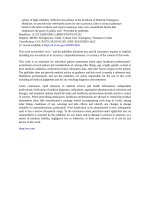Pediatric emergency medicine trisk 719
Bạn đang xem bản rút gọn của tài liệu. Xem và tải ngay bản đầy đủ của tài liệu tại đây (111.79 KB, 4 trang )
findings in patients with neuromuscular instability include Trousseau sign
and Chvostek sign. A positive Trousseau sign is causing a carpopedal
spasm by inflation of a sphygmomanometer above systolic blood pressure
for 3 minutes. A positive Chvostek sign is contraction of the ipsilateral
facial muscle induced by tapping of the facial nerve in front of the ear. Of
note, Chvostek sign may be present in up to 10% of normal subjects. In
addition to neuromuscular findings, acute hypocalcemia may result in
significant cardiovascular disturbance, including hypotension, congestive
heart failure, prolonged QT interval, and dysrhythmias. Papilledema may
also be present and resolves with correction of hypocalcemia.
Management. Numerous forms of calcium salts are available, and
therefore, attention to the salt form is critical when dosing to determine the
elemental calcium dose. Calcium may be provided by either oral
supplementation or IV solution. The appropriate choice is guided by
pertinent clinical findings. In general, IV calcium is indicated if the patient
has prolonged QT, significant symptoms (tetany, seizures, carpopedal
spasm), or acute decrease in serum corrected calcium to less than or equal
to 7.5 mg/dL regardless of symptoms. Oral supplementation is more
appropriate when symptoms are absent or mild and corrected calcium is
greater than or equal to 7.5 mg/dL. In patients with asymptomatic chronic
hypocalcemia associated with CKD, oral calcium supplementation is
preferred with concomitant replacement of 1,25-dihydroxyvitamin D. If
hypocalcemia is associated with metabolic acidosis, correction of the
acidosis will reduce the ionized calcium level. Therefore, if metabolic
acidosis is not causing clinical compromise, priority should be given to
increasing the serum calcium. If hypocalcemia is associated with severe
hyperphosphatemia, the provision of calcium may result in the precipitation
of calcium and phosphate in the tissues, a disorder known as calciphylaxis.
In patients with associated hypomagnesemia, magnesium supplements
should be provided, as persistent hypomagnesemia will hinder the
correction of hypocalcemia.
Prompt treatment of symptomatic or severe acute hypocalcemia should
be initiated intravenously with either calcium chloride or calcium
gluconate. Central access is usually necessary for calcium chloride
infusions, although peripheral infusions may be permissible in emergent
situations. Central access is also preferred for calcium gluconate, though
this salt can be infused peripherally via a large vein. The use of calcium
gluconate is usually favored as it is less likely to result in tissue damage if
extravasation occurs. As concentrated forms are irritating to veins, calcium
salts should be diluted in dextrose and water or saline. The final
concentration of calcium gluconate should be 50 mg/mL, and calcium
chloride should be diluted to 20 mg/mL. Calcium should not be prepared or
infused with fluids containing phosphate or bicarbonate given the risk of
precipitation of insoluble salts. The dose for IV bolus of calcium gluconate
in the setting of cardiac disturbance is 50 to 100 mg/kg/dose infused over 3
to 5 minutes and for tetany is 100 to 200 mg/kg/dose infused over 5 to 10
minutes. Intravenous calcium should not be infused more rapidly given the
risk for cardiac arrhythmia, bradycardia, and arrest. Cardiac monitoring and
serial monitoring of the serum calcium level should be performed. Repeat
boluses should be provided until the symptoms resolve, and then a slower
infusion should be continued.
For patients with either chronic hypocalcemia or milder degrees of acute
hypocalcemia without severe symptoms, oral calcium is preferred.
Numerous forms of oral calcium salts are available. Calcium carbonate is
readily available and well tolerated. If either hypoparathyroidism or vitamin
D deficiency is suspected, vitamin D replacement should be provided to
optimize enteral absorption. The overall management goal of chronic
hypocalcemia is to achieve acceptable serum calcium while avoiding
hypercalcemia and excessive hypercalciuria.
Hypercalcemia
Hypercalcemia results when the influx of calcium into the extracellular
space exceeds the rate of deposition into bone or renal capacity for
excretion. This most commonly results from accelerated bone resorption
secondary to increased PTH activity, but may also occur due to excessive
absorption from the gastrointestinal tract, or decreased renal excretion.
Excessive exposure to vitamin D will increase intestinal calcium and
phosphate absorption and would be associated with a depressed PTH level.
In addition to exogenous sources of vitamin D, granulomatous disorders
may be associated with increased 1,25-dihydroxyvitamin D activity and
promote absorptive hypercalcemia. Accelerated bone resorption would be
anticipated in primary, secondary, and tertiary hyperparathyroidism. Jansen
syndrome, a genetic disorder of the PTH receptor, renders the receptor
constitutively active. Children with Jansen syndrome present with
hypercalcemia, undetectable levels of PTH, and skeletal changes consistent
with hyperparathyroidism. Immobilization, particularly in rapidly growing
adolescents, may result in significant bone resorption and hypercalcemia.
Malignancy is a rare cause of hypercalcemia in children. Decreased renal
excretion occurs in familial hypocalciuric hypercalcemia (FHH), an
autosomal dominant disorder. FHH is characterized by mild, asymptomatic
hypercalcemia, increased tubular reabsorption of calcium, and
inappropriately normal PTH. Hypercalcemia may also be seen in patients
with Williams syndrome, and several metabolic disorders including
hypophosphatasia and Bartter syndrome. Medications associated with
hypercalcemia include thiazide diuretics and lithium.
The evaluation of hypercalcemia begins with a thorough assessment of
symptoms, diet, medications, medical history, and family history.
Laboratory evaluation should include ionized calcium, electrolytes,
phosphorus, magnesium, renal function, serum albumin, and acid–base
assessment. Review of previous laboratory studies, if available, should be
performed. Though results will not be available to the ED physicians, PTH
level is critical to ultimately determine the underlying cause. If the PTH is
not elevated, vitamin D metabolites should be obtained. Assessment of
urine calcium excretion via random urine calcium to creatinine ratio may
also be informative. Calcium excretion is high in hyperparathyroidism but
low in FHH and with thiazide therapy.
Clinical manifestations. Hypercalcemia is associated with a number of
signs and symptoms depending on the acuity and severity of the disorder.
Patients with mildly elevated calcium (less than 11.5 to 12 mg/dL) are often
asymptomatic, especially if the elevation is chronic in onset. Patients with
moderate hypercalcemia (12 to 14 mg/dL) may experience anorexia,
irritability, abdominal pain, constipation, and weakness. An important renal
manifestation of hypercalcemia is polyuria due to an inability to concentrate
urine, an acquired form of nephrogenic diabetes insipidus. Should polyuria
be associated with gastrointestinal symptoms and decreased fluid intake,
dehydration will ensue and aggravate the existing hypercalcemia by
reducing renal excretion of calcium. If hypercalcemia is severe, progressive
weakness, confusion, seizures, and coma may develop.
Management. When hypercalcemia is mild, no specific therapy is
warranted and efforts should focus on identifying the underlying condition.
Chronic moderate hypercalcemia (12 to 14 mg/dL) may be well tolerated
and not require immediate intervention, though thorough evaluation should
be pursued. If hypercalcemia is severe (greater than 14 mg/dL) or
associated with clinically significant symptoms, prompt intervention is
warranted. Given the gastrointestinal and renal manifestations associated
with hypercalcemia, patients may present with hypovolemia. Initial efforts
should focus on restoring adequate intravascular volume with isotonic IV
fluids, which will increase GFR and increase renal excretion of calcium.
Agents that inhibit osteoclasts, such as calcitonin and bisphosphonates, may
be used to treat hypercalcemia secondary to increased bone resorption.
Calcitonin has rapid onset of action but resistance develops rapidly;
bisphosphonates such as pamidronate and zoledronic acid have delayed
onset but long duration of action, so may be useful when combined with
calcitonin. Loop diuretics such as furosemide are no longer routinely
recommended due to risk of hypovolemia and electrolyte imbalance, but
may be used judiciously if necessary to prevent fluid overload in patients
with renal failure or CHF. If the patient is in renal failure or efforts with
saline diuresis and first-line agents are not sufficient, renal replacement
therapy (RRT) may be necessary. Consultation with a pediatric nephrologist
or endocrinologist is advised.
DISORDERS OF ACID–BASE HOMEOSTASIS
Goals of Treatment
Maintenance of normal acid–base balance involves expiration of carbon
dioxide, metabolism of organic acids, and buffering and renal excretion of
nonvolatile acids. Severe uncompensated acid–base disorders are associated
with a variety of cardiovascular, metabolic, neurologic, and respiratory
consequences. General goals include treatment of the underlying etiology
and maintenance of normal pH in order to prevent potentially fatal
sequelae.
CLINICAL PEARLS AND PITFALLS









